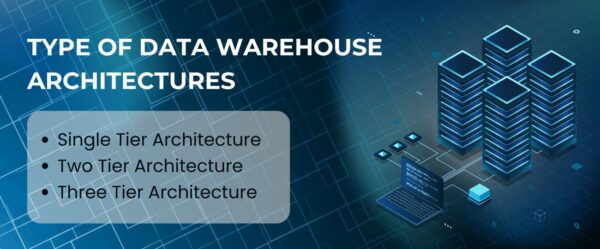Data Warehouse vs Data Lake – Which One Does Your Business Need?
In the digital-first era, companies create and capture data at an unimaginable volume — from social media feeds and transaction histories to customer sentiments and sensor data. Amidst this data explosion, the conventional systems struggle to keep up with such variety and volumes.
This is where the conversation around data warehouses and data lakes becomes relevant — contemporary storage systems are made to tackle sophisticated data requirements with ease.
This article delves into the debate around data warehouse vs. data lake to guide you in making an informed decision for your company.
Whether you’re already investing in data warehouse architecture or prepping to move old systems, grasping this difference is crucial to establishing a future-proof data strategy.
What is a Data Warehouse?
A data warehouse is an organised repository for structured data, used for analytical querying and reporting. It follows a schema-on-write strategy, which implies the data has to be cleaned and structured before it can be stored. These systems are extremely optimized for use with business intelligence (BI) tools, dashboards, and reporting. Some well-known platforms are –
- Snowflake Cloud Data Warehouse
- Amazon Redshift
- Azure Synapse Analytics
Data warehouses often employ data warehouse consulting services to create optimized pipelines and schemas. With services such as Snowflake Cloud Data Warehouse, businesses are provided with scalability, concurrency, and near-zero maintenance advantages.
Additional Read: Tableau vs. Power BI : Key Differences
What is a Data Lake?
Conversely, a data lake is constructed to hold large volumes of raw, unstructured, and semi-structured data — from logs to images to clickstreams. It adopts a schema-on-read approach, and the structure is defined only when data is read and assessed by data scientists and analysts. Data lakes are suited for –
- Machine learning
- Advanced analytics
- Real-time data ingestion
Solutions such as Databricks Solutions and Azure Data Lake are popular in industries. Azure data integration services are also utilized by most businesses to transfer data quickly into lakes and enable hybrid analytics environments. With professional databricks consulting services, organizations can gain insights from disordered, high-volume datasets.
Data Warehouse vs. Data Lake – Key Differences to Note
The following table maps the main difference between data lake and data warehouse.
| Feature | Data Warehouse | Data Lake |
| Structure | Structured (schema-on-write) | Unstructured/Semi-structured (schema-on-read) |
| Performance | Fast for SQL queries & reports | Slower, but flexible for varied queries |
| Use Case | BI, Compliance, Reporting | AI/ML, Exploratory Analysis |
| Cost | Higher due to compute & storage | Cost-effective for raw data storage |
| Tools | Snowflake, Redshift, Power BI | Databricks, Spark, Jupyter Notebooks |
| Security | Mature with fine-grained controls | Evolving, but improving with frameworks |
If you’re employing ETL consulting services to simplify structured reporting, a data warehouse is usually the better choice. But for big-scale ingestion, ETL integration services can be employed to prepare data for lakes as well.
When to Use a Data Warehouse?
You should use a data warehouse when your objective is to –
- Support business intelligence and compliance reporting
- Integrate structured data from multiple systems
- Provide KPI dashboards and performance metrics
Data warehouses harmonize with products such as Power BI reporting tool, Tableau business intelligence, and enterprise ERPs. Products such as Informatica Data Warehouse also improve governance and quality control.
When to Use a Data Lake?
Use a data lake when your organization requires –
- Deep analytics on unstructured or streaming data
- Flexibility to store raw data for future purposes
- Training of AI models, NLP, and predictive analytics
Utilize services such as Azure Databricks and Azure Data Factory integration for effortless processing. For scalable analytics in the long term, most organisations employ Databricks developers to create custom pipelines and AI workflows.
Can You Use Both – The Rise of the Lakehouse Architecture
Totally. Numerous businesses are starting to adopt the lakehouse architecture, a hybrid approach that mixes the performance of a warehouse with the flexibility of a lake. Solutions such as Databricks Solutions and Snowflake are driving this shift by making it possible for structured and unstructured analytics from a single platform.
Through Snowflake Professional Services, it is possible to harmonize your data stack without sacrificing speed or compliance. Numerous enterprises also hire Snowflake developers to execute scalable hybrid data warehouse architectures within departments.
Data Governance and Compliance Considerations
No matter your storage option, data governance is essential. With more emphasis on privacy laws such as India’s DPDP Act, companies need to make sure sensitive data is stored, accessed, and processed safely.
Utilizing DPDP Act compliance services and an established data protection consulting company can assist you with staying compliant on both data warehouses and lakes. This is particularly crucial when handling customer PII or transnational data transfers.
Also Read:: Comparison Between AWS vs. Azure vs. GCP Machine Learning
Conclusion
The decision between data warehouse vs. data lake boils down to your business objectives, current infrastructure, and data maturity. If your operations are heavily BI-focused, optimize for quick analytics with a data warehouse. If innovation and AI are central to your strategy, think about creating or augmenting a data lake.
For most, the solution is somewhere in the middle, in employing a hybrid model — this seamlessly blends the structured world of reporting with the dynamic world of data science.
Still not sure which is the best one for your architecture? Browse our data warehouse consulting services or talk with our Azure data integration and DPDP compliance experts for a customized plan for a scalable and compliant data ecosystem.






